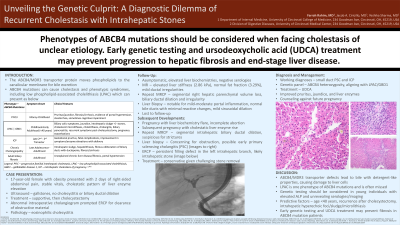Tuesday Poster Session
Category: Liver
P4729 - Unveiling the Genetic Culprit: A Diagnostic Dilemma of Recurrent Cholestasis and Intrahepatic Stones
Tuesday, October 29, 2024
10:30 AM - 4:00 PM ET
Location: Exhibit Hall E

Has Audio
- FR
Farrah Rahim, MD
University of Cincinnati
Cincinnati, OH
Presenting Author(s)
Farrah Rahim, MD, Jacob A. Ciricillo, MD, Yeshika Sharma, MD
University of Cincinnati, Cincinnati, OH
Introduction: Recurrent cholestasis often poses diagnostic challenges and necessitates repeated testing. The ABCB4 (adenosine triphosphate-binding cassette, subfamily B, member 4) gene encodes a protein responsible for removing phospholipids from the hepatic canalicular membrane by excretion of bile salts. ABCB4 mutations can lead to a spectrum of clinical syndromes that cause recurrent cholestasis, including low phospholipid-associated cholelithiasis (LPAC).
Case Description/Methods: A 17-year-old female with history of obesity presented to the hospital with right upper quadrant pain. She was found to have multiple gallstones without acute cholecystitis or biliary dilation on ultrasound. She improved with supportive treatment and underwent laparoscopic cholecystectomy within a week of discharge. An abnormal intraoperative cholangiogram prompted an intra-operative ERCP that showed surgically absent gallbladder and no filling defect. Pathology revealed eosinophilic cholecystitis. Over the next few months, she continued to have a cholestatic pattern of liver injury despite negative serologic workup. Multiple MRCPs showed segmental right hepatic parenchymal volume loss with associated biliary ductal dilation and irregularity, suspicious for a cholangiopathic process. Subsequent liver biopsy noted portal tracts with mild to moderate mixed inflammatory cell infiltrate composed primarily of small lymphocytes with few scattered eosinophils and rare neutrophils. Small bile ducts were in normal number and with minimal reactive change. Later, the patient became pregnant twice and again had worsening of her cholestatic liver injury. It was felt that she had intrahepatic cholestasis of pregnancy overlying her chronic cholestatic injury. Repeat MRCP and ERCP showed persistent filling defect in a left intrahepatic branch, compatible with a likely intrahepatic stone. Given recurrent cholestasis of unclear etiology, she underwent genetic evaluation, testing positive for ABCB4 heterozygosity. Symptoms improved with ursodiol.
Discussion: Our patient offers a challenging case of recurrent liver enzyme elevations in a cholestatic pattern. It is particularly unique given her intrahepatic stones on ERCP and history of recurrent intrahepatic cholestasis of pregnancy. She most likely has LPAC, a phenotype on the spectrum of ABCB4 mutations. Genetic testing should be considered in young individuals with chronic cholestasis with negative serologic workup, intrahepatic cholestasis of pregnancy and intrahepatic stones.
Disclosures:
Farrah Rahim, MD, Jacob A. Ciricillo, MD, Yeshika Sharma, MD. P4729 - Unveiling the Genetic Culprit: A Diagnostic Dilemma of Recurrent Cholestasis and Intrahepatic Stones, ACG 2024 Annual Scientific Meeting Abstracts. Philadelphia, PA: American College of Gastroenterology.
University of Cincinnati, Cincinnati, OH
Introduction: Recurrent cholestasis often poses diagnostic challenges and necessitates repeated testing. The ABCB4 (adenosine triphosphate-binding cassette, subfamily B, member 4) gene encodes a protein responsible for removing phospholipids from the hepatic canalicular membrane by excretion of bile salts. ABCB4 mutations can lead to a spectrum of clinical syndromes that cause recurrent cholestasis, including low phospholipid-associated cholelithiasis (LPAC).
Case Description/Methods: A 17-year-old female with history of obesity presented to the hospital with right upper quadrant pain. She was found to have multiple gallstones without acute cholecystitis or biliary dilation on ultrasound. She improved with supportive treatment and underwent laparoscopic cholecystectomy within a week of discharge. An abnormal intraoperative cholangiogram prompted an intra-operative ERCP that showed surgically absent gallbladder and no filling defect. Pathology revealed eosinophilic cholecystitis. Over the next few months, she continued to have a cholestatic pattern of liver injury despite negative serologic workup. Multiple MRCPs showed segmental right hepatic parenchymal volume loss with associated biliary ductal dilation and irregularity, suspicious for a cholangiopathic process. Subsequent liver biopsy noted portal tracts with mild to moderate mixed inflammatory cell infiltrate composed primarily of small lymphocytes with few scattered eosinophils and rare neutrophils. Small bile ducts were in normal number and with minimal reactive change. Later, the patient became pregnant twice and again had worsening of her cholestatic liver injury. It was felt that she had intrahepatic cholestasis of pregnancy overlying her chronic cholestatic injury. Repeat MRCP and ERCP showed persistent filling defect in a left intrahepatic branch, compatible with a likely intrahepatic stone. Given recurrent cholestasis of unclear etiology, she underwent genetic evaluation, testing positive for ABCB4 heterozygosity. Symptoms improved with ursodiol.
Discussion: Our patient offers a challenging case of recurrent liver enzyme elevations in a cholestatic pattern. It is particularly unique given her intrahepatic stones on ERCP and history of recurrent intrahepatic cholestasis of pregnancy. She most likely has LPAC, a phenotype on the spectrum of ABCB4 mutations. Genetic testing should be considered in young individuals with chronic cholestasis with negative serologic workup, intrahepatic cholestasis of pregnancy and intrahepatic stones.
Disclosures:
Farrah Rahim indicated no relevant financial relationships.
Jacob Ciricillo indicated no relevant financial relationships.
Yeshika Sharma: Intercept Pharmaceuticals – Speakers Bureau.
Farrah Rahim, MD, Jacob A. Ciricillo, MD, Yeshika Sharma, MD. P4729 - Unveiling the Genetic Culprit: A Diagnostic Dilemma of Recurrent Cholestasis and Intrahepatic Stones, ACG 2024 Annual Scientific Meeting Abstracts. Philadelphia, PA: American College of Gastroenterology.

